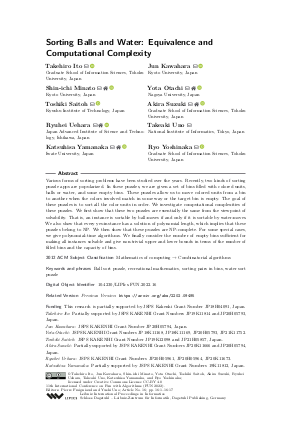Sorting Balls and Water: Equivalence and Computational Complexity
Authors
Takehiro Ito  ,
Jun Kawahara
,
Jun Kawahara  ,
Shin-ichi Minato
,
Shin-ichi Minato  ,
Yota Otachi
,
Yota Otachi  ,
Toshiki Saitoh
,
Toshiki Saitoh  ,
Akira Suzuki
,
Akira Suzuki  ,
Ryuhei Uehara
,
Ryuhei Uehara  ,
Takeaki Uno,
Katsuhisa Yamanaka
,
Takeaki Uno,
Katsuhisa Yamanaka  ,
Ryo Yoshinaka
,
Ryo Yoshinaka 
-
Part of:
Volume:
11th International Conference on Fun with Algorithms (FUN 2022)
Part of: Series: Leibniz International Proceedings in Informatics (LIPIcs)
Part of: Conference: International Conference on Fun with Algorithms (FUN) - License:
 Creative Commons Attribution 4.0 International license
Creative Commons Attribution 4.0 International license
- Publication Date: 2022-05-23
File

PDF
LIPIcs.FUN.2022.16.pdf
- Filesize: 0.83 MB
- 17 pages
Document Identifiers
Related Versions
- Previous Version https://arxiv.org/abs/2202.09495
Subject Classification
ACM Subject Classification
- Mathematics of computing → Combinatorial algorithms
Keywords
- Ball sort puzzle
- recreational mathematics
- sorting pairs in bins
- water sort puzzle
Metrics
- Access Statistics
-
Total Accesses (updated on a weekly basis)
0PDF Downloads0Metadata Views
Abstract
Various forms of sorting problems have been studied over the years. Recently, two kinds of sorting puzzle apps are popularized. In these puzzles, we are given a set of bins filled with colored units, balls or water, and some empty bins. These puzzles allow us to move colored units from a bin to another when the colors involved match in some way or the target bin is empty. The goal of these puzzles is to sort all the color units in order. We investigate computational complexities of these puzzles. We first show that these two puzzles are essentially the same from the viewpoint of solvability. That is, an instance is sortable by ball-moves if and only if it is sortable by water-moves. We also show that every yes-instance has a solution of polynomial length, which implies that these puzzles belong to NP . We then show that these puzzles are NP-complete. For some special cases, we give polynomial-time algorithms. We finally consider the number of empty bins sufficient for making all instances solvable and give non-trivial upper and lower bounds in terms of the number of filled bins and the capacity of bins.
Cite As Get BibTex
Takehiro Ito, Jun Kawahara, Shin-ichi Minato, Yota Otachi, Toshiki Saitoh, Akira Suzuki, Ryuhei Uehara, Takeaki Uno, Katsuhisa Yamanaka, and Ryo Yoshinaka. Sorting Balls and Water: Equivalence and Computational Complexity. In 11th International Conference on Fun with Algorithms (FUN 2022). Leibniz International Proceedings in Informatics (LIPIcs), Volume 226, pp. 16:1-16:17, Schloss Dagstuhl – Leibniz-Zentrum für Informatik (2022)
https://doi.org/10.4230/LIPIcs.FUN.2022.16
BibTex
@InProceedings{ito_et_al:LIPIcs.FUN.2022.16,
author = {Ito, Takehiro and Kawahara, Jun and Minato, Shin-ichi and Otachi, Yota and Saitoh, Toshiki and Suzuki, Akira and Uehara, Ryuhei and Uno, Takeaki and Yamanaka, Katsuhisa and Yoshinaka, Ryo},
title = {{Sorting Balls and Water: Equivalence and Computational Complexity}},
booktitle = {11th International Conference on Fun with Algorithms (FUN 2022)},
pages = {16:1--16:17},
series = {Leibniz International Proceedings in Informatics (LIPIcs)},
ISBN = {978-3-95977-232-7},
ISSN = {1868-8969},
year = {2022},
volume = {226},
editor = {Fraigniaud, Pierre and Uno, Yushi},
publisher = {Schloss Dagstuhl -- Leibniz-Zentrum f{\"u}r Informatik},
address = {Dagstuhl, Germany},
URL = {https://drops.dagstuhl.de/entities/document/10.4230/LIPIcs.FUN.2022.16},
URN = {urn:nbn:de:0030-drops-159867},
doi = {10.4230/LIPIcs.FUN.2022.16},
annote = {Keywords: Ball sort puzzle, recreational mathematics, sorting pairs in bins, water sort puzzle}
}
Author Details
Funding
This research is partially supported by JSPS Kakenhi Grant Number JP18H04091, Japan.
- Ito, Takehiro: Partially supported by JSPS KAKENHI Grant Numbers JP19K11814 and JP20H05793, Japan.
- Kawahara, Jun: JSPS KAKENHI Grant Number JP20H05794, Japan.
- Otachi, Yota: JSPS KAKENHI Grant Numbers JP18K11168, JP18K11169, JP20H05793, JP21K11752.
- Saitoh, Toshiki: JSPS KAKENHI Grant Number JP19K12098 and JP21H05857, Japan.
- Suzuki, Akira: Partially supported by JSPS KAKENHI Grant Numbers JP20K11666 and JP20H05794, Japan.
- Uehara, Ryuhei: JSPS KAKENHI Grant Numbers JP20H05961, JP20H05964, JP20K11673.
- Yamanaka, Katsuhisa: Partially supported by JSPS KAKENHI Grant Numbers 19K11812, Japan.
References
-
Michael R. Garey and David S. Johnson. Computers and Intractability - A Guide to the Theory of NP-Completeness. Freeman, 1979.

- William H. Gates and Christos H. Papadimitriou. Bounds for sorting by prefix reversal. Discret. Math., 27(1):47-57, 1979. URL: https://doi.org/10.1016/0012-365X(79)90068-2.
-
R. A. Hearn and E. D. Demaine. Games, Puzzles, and Computation. A K Peters Ltd., 2009.

-
Hiro Ito, Junichi Teruyama, and Yuichi Yoshida. An almost optimal algorithm for Winkler’s sorting pairs in bins. Progress in Informatics, 9:3-7, 2012.

-
Takehiro Ito, Erik D. Demaine, Nicholas J.A. Harvey, Christos H. Papadimitriou, Martha Sideri, Ryuhei Uehara, and Yushi Uno. On the complexity of reconfiguration problems. Theoretical Computer Science, 412:1054-1065, 2011.

-
Donald E. Knuth. The Art of Computer Programming: Sorting and Searching, volume 3. Addison-Wesley Publishing Company, 2nd edition, 1998.

-
Peter Winkler. Mathematical puzzles: A Connoisseur’s collection, volume 143, pages 149-151. A K Peters, 2004.

-
Katsuhisa Yamanaka, Shin-ichi Nakano, Yasuko Matsui, Ryuhei Uehara, and Kento Nakada. Efficient Enumeration of All Ladder Lotteries and Its Application. Theoretical Computer Science, 411:1714-1722, 2010.

